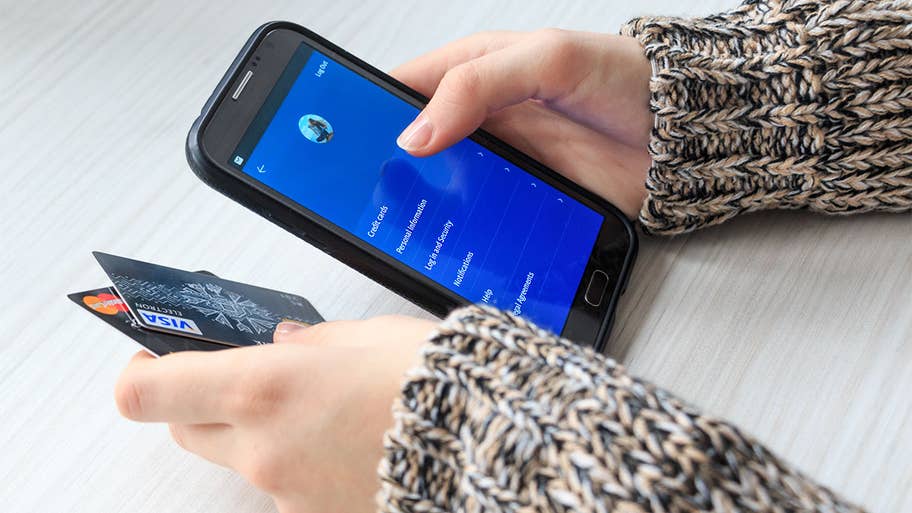
We are an independent, advertising-supported comparison service. Our goal is to help you make smarter financial decisions by providing you with interactive tools and financial calculators, publishing original and objective content, by enabling you to conduct research and compare information for free - so that you can make financial decisions with confidence.
Bankrate has partnerships with issuers including, but not limited to, American Express, Bank of America, Capital One, Chase, Citi and Discover.
The offers that appear on this site are from companies that compensate us. This compensation may impact how and where products appear on this site, including, for example, the order in which they may appear within the listing categories, except where prohibited by law for our mortgage, home equity and other home lending products. But this compensation does not influence the information we publish, or the reviews that you see on this site. We do not include the universe of companies or financial offers that may be available to you.


Written by
Libby Wells
Libby Wells covers banking and deposit products. She has more than 30 years’ experience as a writer and editor for newspapers, magazines and online publications.
Barbara Whelehan
Barbara Whelehan is a contributing writer for Bankrate. Barbara writes about a range of subjects, including homebuying, real estate, retirement, taxes and banking.

Edited by
Marc Wojno
Marc Wojno is a seasoned and accomplished finance editor and writer with more than two decades of experience editing and writing across a variety of news platforms including newswires, newsletters, magazines and online news sites.
At Bankrate we strive to help you make smarter financial decisions. While we adhere to strict editorial integrity , this post may contain references to products from our partners. Here's an explanation for how we make money .
Bankrate logoFounded in 1976, Bankrate has a long track record of helping people make smart financial choices. We’ve maintained this reputation for over four decades by demystifying the financial decision-making process and giving people confidence in which actions to take next.
Bankrate follows a strict editorial policy, so you can trust that we’re putting your interests first. All of our content is authored by highly qualified professionals and edited by subject matter experts, who ensure everything we publish is objective, accurate and trustworthy.
Our banking reporters and editors focus on the points consumers care about most — the best banks, latest rates, different types of accounts, money-saving tips and more — so you can feel confident as you’re managing your money.
Bankrate logoBankrate follows a strict editorial policy, so you can trust that we’re putting your interests first. Our award-winning editors and reporters create honest and accurate content to help you make the right financial decisions. Here is a list of our banking partners.
We value your trust. Our mission is to provide readers with accurate and unbiased information, and we have editorial standards in place to ensure that happens. Our editors and reporters thoroughly fact-check editorial content to ensure the information you’re reading is accurate. We maintain a firewall between our advertisers and our editorial team. Our editorial team does not receive direct compensation from our advertisers.
Bankrate’s editorial team writes on behalf of YOU – the reader. Our goal is to give you the best advice to help you make smart personal finance decisions. We follow strict guidelines to ensure that our editorial content is not influenced by advertisers. Our editorial team receives no direct compensation from advertisers, and our content is thoroughly fact-checked to ensure accuracy. So, whether you’re reading an article or a review, you can trust that you’re getting credible and dependable information.
Bankrate logoYou have money questions. Bankrate has answers. Our experts have been helping you master your money for over four decades. We continually strive to provide consumers with the expert advice and tools needed to succeed throughout life’s financial journey.
Bankrate follows a strict editorial policy, so you can trust that our content is honest and accurate. Our award-winning editors and reporters create honest and accurate content to help you make the right financial decisions. The content created by our editorial staff is objective, factual, and not influenced by our advertisers.
We’re transparent about how we are able to bring quality content, competitive rates, and useful tools to you by explaining how we make money.
Bankrate.com is an independent, advertising-supported publisher and comparison service. We are compensated in exchange for placement of sponsored products and services, or by you clicking on certain links posted on our site. Therefore, this compensation may impact how, where and in what order products appear within listing categories, except where prohibited by law for our mortgage, home equity and other home lending products. Other factors, such as our own proprietary website rules and whether a product is offered in your area or at your self-selected credit score range, can also impact how and where products appear on this site. While we strive to provide a wide range of offers, Bankrate does not include information about every financial or credit product or service.
For many, mobile banking has become a cornerstone of personal money management. It enables you to do such tasks as check your balance, transfer money and pay bills, with just a few taps. In fact, nearly half (48 percent) of bank customers are using apps on phones or other mobile devices as their top option for managing their bank accounts, the American Bankers Association found.
But is mobile banking truly safe? Bank fraud is popular with identity thieves, who steal personal credentials, usually for financial gain.
Cybersecurity experts say mobile banking is safe, but urge consumers to take certain precautions.
“If you download the mobile app from a secure store, that is just as safe as visiting a bank branch,” says Paul Benda, senior vice president for operational risk and cybersecurity at American Bankers Association.
Benda says the safest place to download a mobile banking app is from your bank’s website.
“Banks use extremely secure, high-end encryption technologies,” Benda says. “We like saying that mobile apps are like having a bank branch in your pocket.”
There are myriad ways that fraudsters target consumers. but the FBI cites two forms of cyberattacks in particular:
These are hidden in unrelated apps such as games or tools that are downloaded by unsuspecting bank customers. These “sideload” apps, which are downloaded from unofficial sources, might conceal malware that is dormant until a user launches a legitimate banking app. Then the Trojan creates a pop-up overlay that mimics the bank’s login page. When customers enter their username and password, they are seamlessly directed to the legitimate banking app login page, with no idea that they have been scammed.
“The malware can be downloaded in a variety of ways, such as SMS (short message service, or text) with a malicious hyperlink,” says Teresa Walsh, global head of intelligence at Financial Services Information Sharing and Analysis Center (FS-ISAC), which mitigates cyber threats in financial services. “This type of malware is actually on sale on the criminal underground marketplace.”
These apps impersonate the real mobile apps of banks and are designed to trick users into entering their login credentials. The FBI say it is “one of the fastest growing sectors of smartphone-based fraud.”
If you’re worried about using a mobile banking app, be aware that security threats exist everywhere, including inside the bank lobby.
“There is the risk that the bank employee will do something that is illegal, like stealing your banking information; this is known as an insider threat,” says Donald Korinchak of CyberExperts.com.
With a mobile app, “there are potential vulnerabilities related to the security posture of the app itself – vulnerabilities in code, encryption methods, et cetera – and also potential vulnerabilities related to the transmission of information,” he says.
“In both scenarios, the bank invests heavily to ‘bake in’ security,” Korinchak says. Financial institutions monitor their employees’ behavior and also look for vulnerabilities in their app that can be patched before they are exploited by criminals.
There are also precautions you can take to reduce the risk.
Many banks feature links to the app stores from their websites to help you download the right app. “Your bank should have available information on what type of mobile app they use, what features are on it and what you need for access to it,” FS-ISAC’s Walsh says. “Then, use a reliable app store, paying attention to the owner/developer of the app and whether there are other apps with the same name.”
Talk to your bank to make sure, but never download an app found on an open forum.
Two-factor or multi-factor authentication requires bank customers to prove their identity when logging in to accounts by providing at least two pieces of authenticating information. This is usually a password or PIN as well as a confirmation code sent via text message to their cellphone.
Two-factor authentication vastly increases security, Korinchak says, but isn’t 100 percent secure. “Someone could gain access to your phone or someone could intercept the SMS traffic to gain access to the code,” he says
One of the best ways to protect yourself is to use a password that contains random upper and lower case letters, numbers and symbols. Don’t ask your browser to remember it for you either; use a reputable password manager instead.
“Reputable password managers are coded in a way that reduces risk to the user and are highly hardened against potential attackers,” Korinchak says. “Most cyber security experts recommend password manager software.”
When you log on to a public Wi-fi hotspot, you often get a warning that you’re not on a secure network, and that others may be able to watch your online actions. That’s a strong reason not to conduct any financial business using a public network. Instead, use your cellular network or your home wi-fi to better protect your personal information.
Phishing emails often look legitimate, like they really are from your bank or credit card issuer. But ID thieves use them to trick people into divulging personal information, and they may contain malware.
Smishing is the same tactic, but conducted through text messages.
“Users should be familiar with their banking application in the first place to detect abnormal questions or pop-ups that look slightly different than the usual features,” Walsh says.
A quick notification from your bank about transactions on your account can help you detect potential fraudulent activity. You can then address the matter with your bank in a timely manner.
Banks, credit unions and investment firms invest heavily to shield themselves against cyberattacks.
“I think it’s safe to say banks spend billions to protect customer accounts,” says ABA’s Benda. “Due to Regulation E, they’re on the hook if there’s an attack.”
Regulation E limits consumer liability to $50 if an unauthorized electronic funds transfer is caught by a customer within two business days, and up to $500 if caught outside the two-day window. Financial institutions are responsible for everything above that amount.
“Banks have very robust controls in place to control fraudulent activity,” says Benda. “A lot depends on consumer behavior, making sure consumers follow safe practices.”
Banks, especially online-only banks, spend a lot of time and money to protect their digital operations (including mobile apps) and their customers from theft and fraud. Customers have to do their part too to best guard against attacks by practicing safe mobile banking habits.
—Bankrate senior writer Karen Bennett contributed to an update of this story.

Arrow Right Former Contributing writer, Credit Cards
Libby Wells covers banking and deposit products. She has more than 30 years’ experience as a writer and editor for newspapers, magazines and online publications.

Barbara Whelehan is a contributing writer for Bankrate. Barbara writes about a range of subjects, including homebuying, real estate, retirement, taxes and banking.